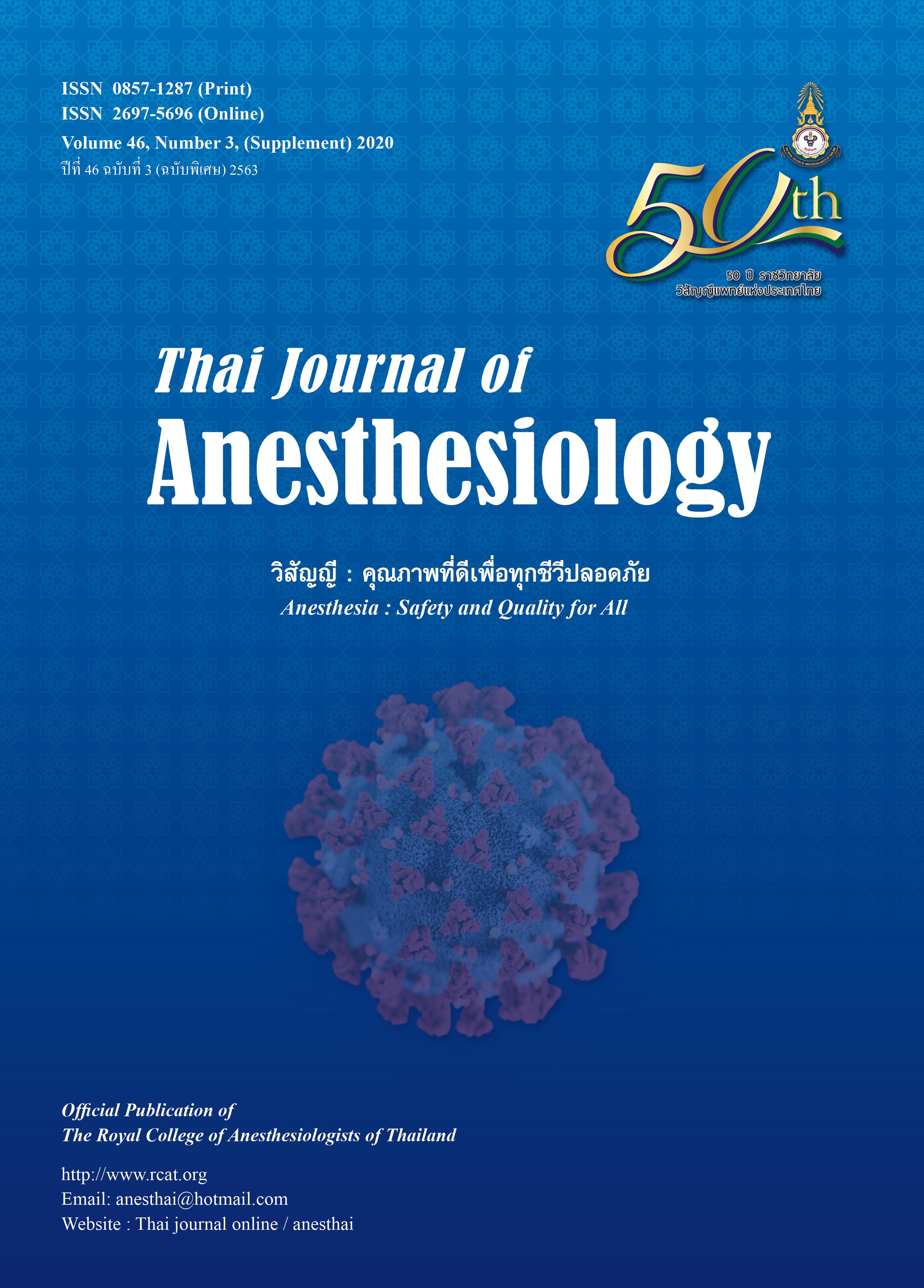Anesthetic Management in Tracheostomy for COVID-19 Patients and Patients under Investigation: A Review Article for Better and Safe Perioperative Care
Main Article Content
Abstract
Objective: The rapidly, worldwide spreading of COVID-19
assaults the pulmonary system to acute respiratory
distress syndrome (ARDS) and prolonged intubation and
required tracheostomy. Various recommendations are
published with some debating points. This review aims to
provide data and suggestion for anesthetic personnel,
regarding tracheostomy in patients with positive or
unknown COVID-19 results.
Methods: All articles related evidences to this topic were
reviewed and compared. A practical guideline was
proposed base on the reviewed data.
Result: An organized, detailed recommendation is
presented concerning evidence-based and safety concerns.
Tracheostomy should be performed in patients with
COVID-19, after 14 days of intubation with non-fenestrated
tube. Practical steps for anesthesia personnel for
tracheostomy are fully paralyze the patient, preoxygenate
with 100% oxygen and positive end-expiratory pressure
(PEEP), advance the endotracheal tube before opening
the trachea, and stop the ventilation without unnecessary
disconnection of the circuit. Details of practical steps are
listed and integrated for better patients care.
Conclusions: Tracheostomy in patients with COVID-19
is a rare procedure. However, tracheostomy in the patient
under investigation (PUI) case seems to be more common.
Indication of tracheostomy must be fulfilled to balance the
infection risk of health care personnel.
Article Details
References
Situation Report–125. 2020 May [cited 2020 May 25].
Available from: https://www.who.int/emergencies/diseases/
novel-coronavirus-2019/situation-reports.
2. Center of disease control and prevention. COVIDView, a
weekly survillance summary of U.S. COVID-19 activity. 2020
May [cited 2020 May 25]. Available from: https://www.cdc.
gov/coronavirus/2019-ncov/covid-data/covidview/index.
html.
3. Wu Z, McGoogan JM. Characteristics of and important
lessons from the Coronavirus disease 2019 (COVID-19)
outbreak in China: summary of a report of 72314 cases from
the Chinese center for disease control and prevention. JAMA
2020. DOI: 10.1001/jama.2020.2648.
4. Lai X, Wang M, Qin C, et al. Coronavirus disease 2019
(COVID-2019) infection among health care workers and
implications for prevention measures in a tertiary hospital in
Wuhan, China. JAMA Netw Open. 2020;3:e209666.
5. Tran K, Cimon K, Severn M, Pessoa-Silva CL, Conly J.
Aerosol generating procedures and risk of transmission of
acute respiratory infections to healthcare workers: a
systematic review. PLoS One 2012;7:e35797.
6. Li Q, Guan X, Wu P, et al. Early transmission dynamics in
Wuhan, China, of novel Coronavirus-infected pneumonia.
N Engl J Med 2020;382:1199-207.
7. McGrath BA, Brenner MJ, Warrillow SJ, et al. Tracheostomy
in the COVID-19 era: global and multidisciplinary guidance.
Lancet Respir Med 2020. DOI.org/10.1016/S2213-2600(20)
30230-7
8. Huang C, Wang Y, Li X, et al. Clinical features of patients
infected with 2019 novel coronavirus in Wuhan, China.
Lancet 2020;395:497-506.
9. Yang X, Yu Y, Xu J, et al. Clinical course and outcomes of
critically ill patients with SARS-CoV-2 pneumonia in Wuhan,
China: a single-centered, retrospective, observational study.
Lancet Respir Med 2020;8:475-81.
10. Chorin E, Wadhwani L, Magnani S, et al. QT interval
prolongation and Torsade de Pointes in patients with COVID-
19 treated with hydroxychloroquine/azithromycin. Heart
Rhythm 2020 May 11. DOI.org/10.1016/j.hrthm.2020.05.014
11. Marcucci C SN, DeCaro MV, Nicholson WT. Summary of
chloroquine and hydroxychloroquine drug-drug Interactions.
2020 Mar [cited 2020 May 25]. Available from: https://www.
apsf.org/article/summary-of-chloroquine-and-hydroxychloroquine-
drug-drug-interactions/.
12. FDA. Hydroxychloroquine or chloroquine for COVID-19: drug
safety communication - FDA cautions against use outside of
the hospital setting or a clinical trial due to risk of heart rhythm
problems. 2020 Apr [cited 2020 May 22]. Available from:
https://www.fda.gov/safety/medical-product-safetyinformation/
hydroxychloroquine-or-chloroquine-covid-
19-drug-safety-communication-fda-cautions-against-use.
13. Tay JK, Khoo ML, Loh WS. Surgical considerations for
tracheostomy during the COVID-19 pandemic: lessons
learned from the severe acute respiratory syndrome
outbreak. JAMA Otolaryngol Head Neck Surg 2020 Mar 31.
DOI:10.1001/jamaoto.2020.0764
14. Takhar A, Walker A, Tricklebank S, et al. Recommendation
of a practical guideline for safe tracheostomy during the
COVID-19 pandemic. Eur Arch Otorhinolaryngol 2020 Apr
21. DOI: 10.1007/s00405-020-05993-x
15. Chee VW, Khoo ML, Lee SF, Lai YC, Chin NM. Infection
control measures for operative procedures in severe acute
respiratory syndrome-related patients. Anesthesiology
2004;100:1394-8.
16. Tien HC, Chughtai T, Jogeklar A, Cooper AB, Brenneman F.
Elective and emergency surgery in patients with severe acute
respiratory syndrome (SARS). Can J Surg 2005;48:71-4.
17. Givi B, Schiff BA, Chinn SB, et al. Safety recommendations
for evaluation and surgery of the head and neck during the
COVID-19 pandemic. JAMA Otolaryngol Head Neck Surg
2020 Mar 31. DOI:10.1001/jamaoto.2020.0780.
18. Foster P, Cheung T, Craft P, et al. Novel Approach to reduce
transmission of COVID-19 during tracheostomy. J Am Coll
Surg 2020 Apr 10. DOI: 10.1016/j.jamcollsurg.2020.04.014
19. Filho WA, Teles T, da Fonseca MRS, et al. Barrier device
prototype for open tracheotomy during COVID-19 pandemic.
Auris Nasus Larynx 2020 May 8. DOI: 10.1016/j.anl.2020.
05.003
20. Schultz P, Morvan JB, Fakhry N, et al. French consensus
regarding precautions during tracheostomy and
post-tracheostomy care in the context of COVID-19
pandemic. Eur Ann Otorhinolaryngol Head Neck Dis
2020;137:167-9.
21. Jacob T, Walker A, Mantelakis A, Gibbins N, Keane O. A
framework for open tracheostomy in COVID-19 patients. Clin
Otolaryngol 2020 Apr 13. DOI: 10.1111/coa.13549
22. ENT UK. Tracheostomy guidance during the COVID-19
pandemic. 19 March 2020 [cited 2020 May 25]. Available
from: https://www.entuk.org/tracheostomy-guidance-duringcovid-
19-pandemic-l-harrison-et-al.
23. Wax RS, Christian MD. Practical recommendations for critical
care and anesthesiology teams caring for novel coronavirus
(2019-nCoV) patients. Can J Anaesth 2020;67:568-76.
24. England. PH. Environmental decontamination, in COVID-19:
infection prevention and control guidance. 2020 May [cited
2020 May 25]. Available from: https://assets.publishing.
service.gov.uk/government/uploads/system/uploads/attachment_
data/file/886668/COVID-19_Infection_prevention_and_
control_guidance_complete.pdf.
25. Xiao H, Zhong Y, Zhang X, Cai F, Varvares MA. How to avoid
nosocomial spread during tracheostomy for COVID-19
patients. Head Neck 2020 Apr 16. DOI.org/10.1002/
hed.26167
26. American Academy of Otolaryngology- Head and Neck
Surgery. Tracheotomy recommendations during the
COVID-19 pandemic. 2020 Apr [cited 2020 May 25].
Available from: https://www.entnet.org/content/tracheotomyrecommendations-
during-covid-19-pandemic.
27. Michetti CP, Burlew CC, Bulger EM, et al. Performing
tracheostomy during the Covid-19 pandemic: guidance and
recommendations from the Critical Care and Acute Care
Surgery Committees of the American Association for the
Surgery of Trauma. Trauma Surg Acute Care Open 2020;
5:e000482. DOI.org/10.1136/tsaco-2020-000482.


